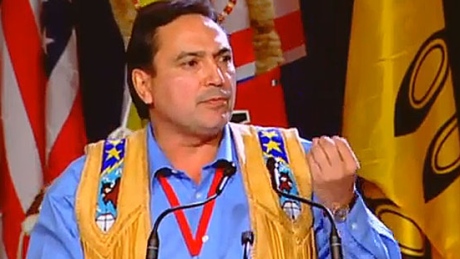With the choice of a new National Chief this week, the Assembly of First Nations may appear to take a step toward rebuilding itself, but any success it has will collide with other forces of realignment in which the Supreme Court of Canada is playing a pivotal role.
Perry Bellegarde, who is almost certain to be elected as the next AFN National Chief on the first ballot Wednesday, will assume leadership of an organization splintered in several different directions. The longstanding challenge of speaking in one voice for over 600 Chiefs with a wide variety of histories and opinions has been complicated by a growing division between those Chiefs and their newly empowered constituencies. The better educated and far more vocal grassroots are refusing to be idle not only in the face of ongoing hostility from the federal government, but in response to Chiefs and Councils from whom they feel increasingly distanced. This is in part due to the physical distance of half the population living off reserve, in part due to growing frustration with intolerable living conditions for those remaining on reserve, and in part due to an effective campaign by the federal government and its allies to portray all political leadership as undeserving, band councils included.
Add to these divisions a growing gulf between First Nations with a land treaty and those without.
This June’s Supreme Court decision in Tsilhqot’in marked a critical point in a 40-year legal battle to gain recognition of Aboriginal land title. For bands throughout B.C. and Atlantic Canada, as well as many in Quebec and a few elsewhere across the country, it stands as a goal marker for the fullest recognition of rights to self-government and control over resource development: the most complete sovereignty possible without seceding from Canada entirely.
For other First Nations from Ontario through Alberta, covered by treaties that Canada claims surrendered land title, legal battles largely have been limited to winning the right to consultation and accommodation rather than consent; subsistence rights over the harvesting of fish and game rather than full ownership of energy and mineral resources; and continued subjugation under the Indian Act rather than self-government. It is no coincidence that divisions over the Harper plan for First Nations education split along similar geographic lines.
And on the horizon for 2015, a win at the Supreme Court for non-status Indians in the upcoming Daniels decision will complicate matters enormously, putting the composition of communities holding Aboriginal rights and the number of people who may exercise them at issue.
If, as is likely, the Court recognizes individual non-status Indians and Métis people as a federal responsibility under section 91(24) of the Constitution, the logical extension is that the Aboriginal communities to which those individuals belong hold the communal rights affirmed under section 35 of that document. While section 35 rights are already recognized for the Métis, non-status communities of Mi’kmaq throughout Atlantic Canada, Algonquin in Ontario, and many others across the country are then players in land title cases right along with reserve communities. Indeed, language in the Tsilhqot’in decision suggests that the participation of non-status communities in land claims would only strengthen the breadth and depth of reserve community efforts to have title recognized. Conversely, leaving the non-status out could lead to legal infighting and stall progress. Giving consideration to all of the legal interests at play suggests an entirely new alignment of interests, with reconstructed First Nations seeking full title and rights for all of their peoples, on and off reserve, whether holding status under the Indian Act or not.
Supplementing these legal motives, there are several other reasons for reconstructing the original nations. With Indigenous communities rather than the Government of Canada deciding who is and is not a member, such a voice would have greater legitimacy and a more traditional, rather than colonial, relationship to citizens. It would provide an opportunity to address activist and grassroots concerns about their political leadership, to find a unified voice for off-reserve and non-status First Nation citizens as well those on-reserve. And, if in the end there are one-tenth the number of First Nations than Indian Act bands, this would provide economies of scale for the institutions of government and re-create larger, stronger Indigenous governments that are better placed to engage in nation-to-nation dialogue with Canada.
Whether the next AFN National Chief manages to find a way to deal with the Harper government or not, the broader forces at play politically, historically, and especially legally, may render that effort secondary to the reassembly of the original First Nations.




